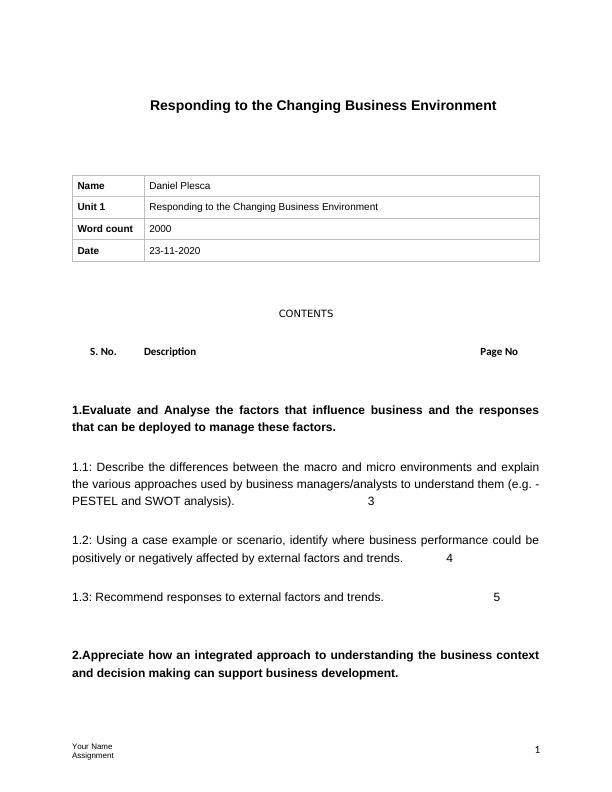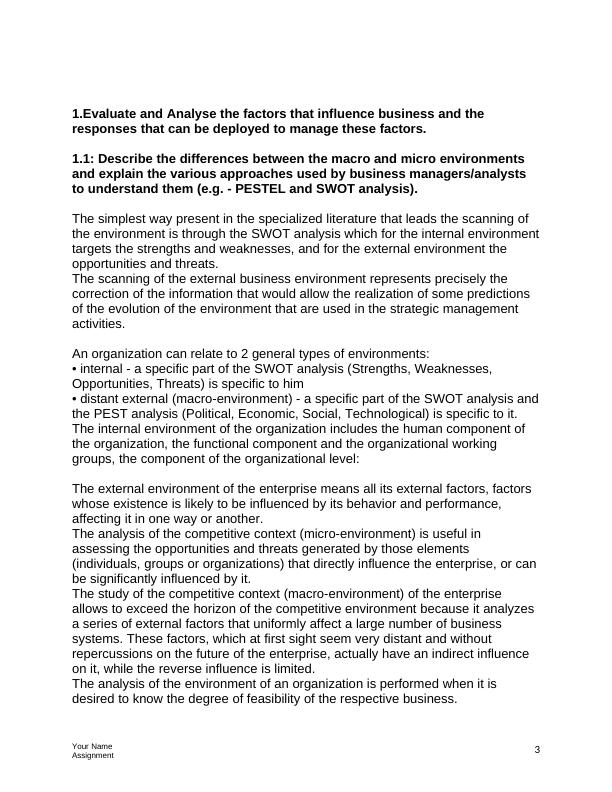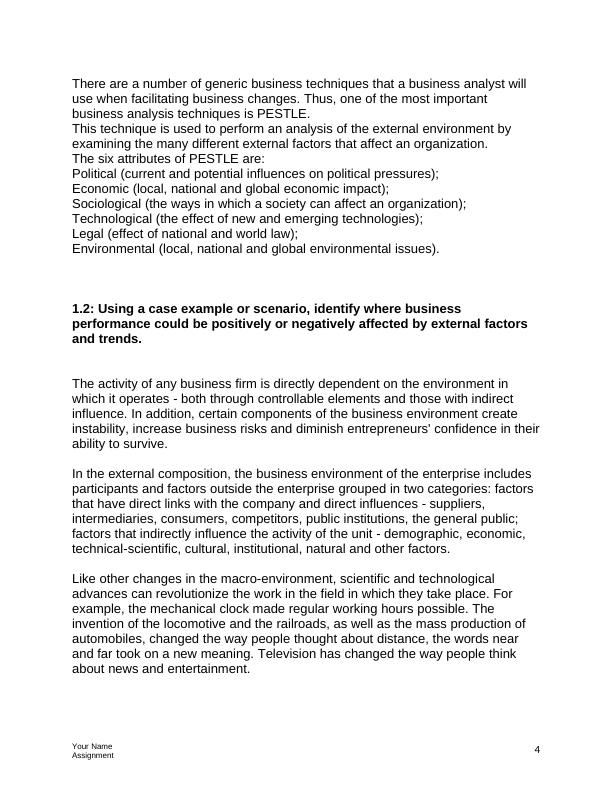Ask a question from expert
Respond to Change in a Business Environment
12 Pages4028 Words761 Views
Added on 2021-03-17
Respond to Change in a Business Environment
Added on 2021-03-17
BookmarkShareRelated Documents
Responding to the Changing Business EnvironmentNameDaniel PlescaUnit 1Responding to the Changing Business EnvironmentWord count2000Date23-11-2020CONTENTSS. No.Description Page No1.Evaluate and Analyse the factors that influence business and the responsesthat can be deployed to manage these factors. 1.1: Describe the differences between the macro and micro environments and explainthe various approaches used by business managers/analysts to understand them (e.g. -PESTEL and SWOT analysis). 31.2: Using a case example or scenario, identify where business performance could bepositively or negatively affected by external factors and trends. 4 1.3: Recommend responses to external factors and trends. 52.Appreciate how an integrated approach to understanding the business contextand decision making can support business development. Your Name Assignment 1

2.1: Using a case example, evaluate the role played by management in responding to achanging business environment. 62.2: Using your case example, Identify and prioritise organisational changes that wouldexploit positive or counteract negative business environmental factors and trends.62.3: Explain the potential impact of responding to business environmental factors andtrends. 73.Investigate the changing relationship between the private and public sector. 3.1: Explain changes in the relationship between business, government and the publicsector. 83.2: Use scenarios and models to illustrate changes in relationships. 93.3: Identify opportunities that may arise due to changes in relationships. 10Your Name Assignment 2

1.Evaluate and Analyse the factors that influence business and the responses that can be deployed to manage these factors. 1.1: Describe the differences between the macro and micro environments and explain the various approaches used by business managers/analysts to understand them (e.g. - PESTEL and SWOT analysis). The simplest way present in the specialized literature that leads the scanning of the environment is through the SWOT analysis which for the internal environmenttargets the strengths and weaknesses, and for the external environment the opportunities and threats.The scanning of the external business environment represents precisely the correction of the information that would allow the realization of some predictions of the evolution of the environment that are used in the strategic management activities.An organization can relate to 2 general types of environments:• internal - a specific part of the SWOT analysis (Strengths, Weaknesses, Opportunities, Threats) is specific to him• distant external (macro-environment) - a specific part of the SWOT analysis andthe PEST analysis (Political, Economic, Social, Technological) is specific to it.The internal environment of the organization includes the human component of the organization, the functional component and the organizational working groups, the component of the organizational level:The external environment of the enterprise means all its external factors, factors whose existence is likely to be influenced by its behavior and performance, affecting it in one way or another.The analysis of the competitive context (micro-environment) is useful in assessing the opportunities and threats generated by those elements (individuals, groups or organizations) that directly influence the enterprise, or canbe significantly influenced by it.The study of the competitive context (macro-environment) of the enterprise allows to exceed the horizon of the competitive environment because it analyzes a series of external factors that uniformly affect a large number of business systems. These factors, which at first sight seem very distant and without repercussions on the future of the enterprise, actually have an indirect influence on it, while the reverse influence is limited.The analysis of the environment of an organization is performed when it is desired to know the degree of feasibility of the respective business.Your Name Assignment 3

There are a number of generic business techniques that a business analyst will use when facilitating business changes. Thus, one of the most important business analysis techniques is PESTLE.This technique is used to perform an analysis of the external environment by examining the many different external factors that affect an organization.The six attributes of PESTLE are:Political (current and potential influences on political pressures);Economic (local, national and global economic impact);Sociological (the ways in which a society can affect an organization);Technological (the effect of new and emerging technologies);Legal (effect of national and world law);Environmental (local, national and global environmental issues).1.2: Using a case example or scenario, identify where business performance could be positively or negatively affected by external factors and trends.The activity of any business firm is directly dependent on the environment in which it operates - both through controllable elements and those with indirect influence. In addition, certain components of the business environment create instability, increase business risks and diminish entrepreneurs' confidence in theirability to survive.In the external composition, the business environment of the enterprise includes participants and factors outside the enterprise grouped in two categories: factors that have direct links with the company and direct influences - suppliers, intermediaries, consumers, competitors, public institutions, the general public; factors that indirectly influence the activity of the unit - demographic, economic, technical-scientific, cultural, institutional, natural and other factors.Like other changes in the macro-environment, scientific and technological advances can revolutionize the work in the field in which they take place. For example, the mechanical clock made regular working hours possible. The invention of the locomotive and the railroads, as well as the mass production of automobiles, changed the way people thought about distance, the words near and far took on a new meaning. Television has changed the way people think about news and entertainment.Your Name Assignment 4

End of preview
Want to access all the pages? Upload your documents or become a member.
Related Documents
Context of Businesslg...
|14
|4044
|207
Unit 1 - Business and Business Envỉonment Assignmentlg...
|21
|4959
|271
SWOT and PESTEL Analysis of Amazonlg...
|11
|3512
|51
Responding to the Changing Businesslg...
|11
|2920
|25
Marketing Sales and Negotiation skills - Analysis of Unilever's PESTEL and SWOT, Marketing Mix, Sales and Negotiation Skillslg...
|13
|2513
|310
Business Environment Analysis of BBClg...
|12
|3817
|53